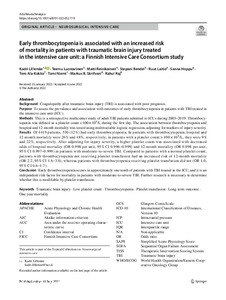Early thrombocytopenia is associated with an increased risk of mortality in patients with traumatic brain injury treated in the intensive care unit: a Finnish Intensive Care Consortium study
Lillemäe Kadri; Luostarinen Teemu; Reinikainen Matti; Bendel Stepani; Laitio Ruut; Hoppu Sanna; Ala-Kokko Tero; Niemi Tomi; Skrifvars Markus B; Raj Rahul
https://urn.fi/URN:NBN:fi-fe2022091258622
Tiivistelmä
Background
Coagulopathy after traumatic brain injury (TBI) is associated with poor prognosis.
Purpose
To assess the prevalence and association with outcomes of early thrombocytopenia in patients with TBI treated in the intensive care unit (ICU).
Methods
This is a retrospective multicenter study of adult TBI patients admitted to ICUs during 2003-2019. Thrombocytopenia was defined as a platelet count < 100 x 10(9)/L during the first day. The association between thrombocytopenia and hospital and 12-month mortality was tested using multivariable logistic regression, adjusting for markers of injury severity.
Results
Of 4419 patients, 530 (12%) had early thrombocytopenia. In patients with thrombocytopenia, hospital and 12-month mortality were 26% and 48%, respectively; in patients with a platelet count > 100 x 10(9)/L, they were 9% and 22%, respectively. After adjusting for injury severity, a higher platelet count was associated with decreased odds of hospital mortality (OR 0.998 per unit, 95% CI 0.996-0.999) and 12-month mortality (OR 0.998 per unit, 95% CI 0.997-0.999) in patients with moderate-to-severe TBI. Compared to patients with a normal platelet count, patients with thrombocytopenia not receiving platelet transfusion had an increased risk of 12-month mortality (OR 2.2, 95% CI 1.6-3.0), whereas patients with thrombocytopenia receiving platelet transfusion did not (OR 1.0, 95% CI 0.6-1.7).
Conclusion
Early thrombocytopenia occurs in approximately one-tenth of patients with TBI treated in the ICU, and it is an independent risk factor for mortality in patients with moderate-to-severe TBI. Further research is necessary to determine whether this is modifiable by platelet transfusion.
Kokoelmat
- Rinnakkaistallenteet [27093]
